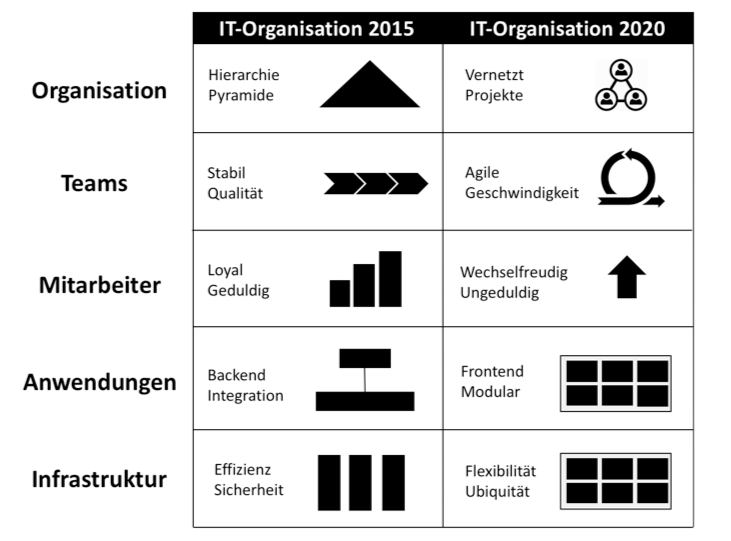“ In the medium term, the IT department will have changed in such a way that it no longer has anything in common with its current state. “warns that Magazine CIO . But what will change in the IT organization in 2020? According to the magazine, a reorganization of IT in order to better understand it with the requirements of the business side is on the agenda of a good 70 percent of companies worldwide.
Also in Oracle’s blog there is a discussion about the IT organization 2020. So says the blog: In today’s technology world, it’s less about operational deployment and infrastructure than about finding solutions and doing business together. IT departments are becoming smaller as companies outsource operational activities to external service providers. More than ever, end users are required to ensure that functions run smoothly.
Reading tip: What is an IT organization
Now, in most of the results on Google, I did not find any specific indications of the changes. For this reason I looked again in academic databases and the thoughts of Prof. Dr. Urbach and his co-author F. Ahlemann transferred to the article. Both authors represent the IT organization 2015 and 2020, which I am reproducing here in a heavily modified manner.

The drivers: organization, teams and individuals
But why should IT change so? I see three drivers for this: people, teams and organizations. In the following I would like to explain these new framework conditions for IT. The new IT requirements can then be derived from these.
organization
Organizations were traditionally organized up to now, with a focus on controllability and control. Due to increasing complexity, this has changed to project orientation and agile methods. Networking and a flat hierarchy shape the organizations and thus also change the demands on IT.
Teams
While teams and departments were stable for a long time and often little networked or worked across departmental boundaries, networked teams and constantly changing roles can now be found more and more frequently in companies. IT is therefore required to provide flexible hardware and software for this permanent change and to support cross-functional teams.
Employee
While employees have usually been with a company for a long time and also on one job, things are different now. Frequent company and role changes are state-of-the-art. This can already be felt today. For this reason, IT is required to provide flexible workplaces that can cope with these constant changes.
The IT organization 2020 – infrastructure and applications
People, teams and organizations are becoming more flexible and are demanding new tools from IT that support these processes. This is noticeable in applications and infrastructure, which I would like to explain in more detail below.
While IT development often developed the backend and frontend separately and infrastructures should run stably and efficiently, the weighting is now changing. The IT should meet the new flexibility requirements of employees. So I find the term IT platform more and more. By the way, I mention the word ubiquitous in the graphic. The adjective ubiquitous comes from Latin, where ubique means “everywhere” (Source: New word ).
Urbach and Ahlemann write on the topic of the IT platform: New platform strategies are required to support any end device for ubiquitous access to information. The user expects from the knowledge workplace of the future that the company’s central applications and services can be used with all end devices used – regardless of the hardware manufacturer and the operating system used.
For this reason the authors propose a flexible platform. Thus, different modules are to be created on the platform, which enable the work from any end device and whereby the change of the end device does not have a negative effect on the work. So Urbach and Ahlemann recommend that The development platforms guarantee the security of the systems regardless of the underlying hardware and should offer universal functionality for access to the backend systems. As current examples of such platforms, the authors name: Xamarin1, PhoneGap2, Kony3 or 5App4,
Conclusion: more agile, faster and more flexible – IT Organization 2020
In conclusion, the IT organization will be faster, more agile and more flexible in 2020. Thus, agile teams and DevOps methods will establish themselves. According to a study by Cobalt blue Therefore, by 2020 40% of all employees will work agile and 25% of them in so-called DevOps teams. This means that 40% of all applications are developed in an agile manner and then also have to be supported in DevOps mode. By then, 50% of all applications should also be built on cloud infrastructures and designed according to the latest best practices. It is therefore evident that the changes in the illustration by Urbach and Ahlemann (2016) could occur and that agile methods will probably be more and more necessary in the IT organization in 2020.
- Reading tip: IT organizational models
- Reading tip: IT organizational forms
Urbach, N., & Ahlemann, F. (2016). The changing IT organization: Implications of digitization for IT management. HMD Praxis der Wirtschaftsinformatik , 54 (3), 300-312. https://doi.org/10.1365/s40702-017-0313-6



